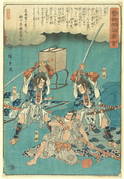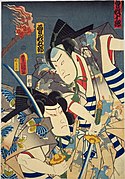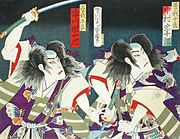Soga Tokimune
Soga Tokimune 曾我時致 | |
|---|---|
 Tsuki no Hyakushi Ugo no Sangetsu Tokimune by Yoshitoshi | |
| Born | 1174 |
| Died | June 29, 1193 |
| Nationality | Japanese |
| Other names | Gorō, Hako'ō |
| Occupation | samurai |
| Children | |
| Parent(s) |
|
Soga Tokimune (Japanese: 曾我時致, 1174 - June 29, 1193) was a samurai in the early Kamakura period. He is known for his participation in the incident known as the Revenge of the Soga Brothers. He is also known as Soga Gorō.
Life[]
Kawazu Hako'ō (河津 筥王) was born in 1174 as the son of Kawazu Sukeyasu.
In 1176, when Hako'ō was two years old, his biological father, Kawazu Sukeyasu, was killed by Kudō Suketsune, who accidentally killed him when he attempted to assassinate . Suketsune and Sukechika had been quarreling over the inheritance of land. After that, Hako'ō's mother remarried to , the lord of Soga Manor in Sagami Province (currently Odawara, Kanagawa Prefecture), who became Hako'ō's stepfather.[1] Hako'ō, along with his elder brother Ichimanmaru (later Sukenari), are said to have mourned for their biological father.[2]
The Soga brothers, grandsons of Sukechika, had a difficult upbringing, and the elder brother Sukenari took over the Soga family.[2] Hako'ō hated priesthood and escaped from Hakone, relying on his uncle by marriage, Hōjō Tokimasa, whose late wife was the daughter of Sukechika.[2][3] Hako'ō held his coming-of-age ceremony (genpuku) at Tokimasa's mansion with Tokimasa as his guardian (eboshi-oya). Tokimasa bestowed the kanji "toki" (時) in his name upon Hako'ō, giving him the imina name Tokimune.[4] Tokimasa would be the greatest supporter of the Soga brothers in the midst of their hardships, and the Soga brothers never forgot their father's vengeance.[2]

In June 1193, Tokimune, Sukenari, and their father's killer Suketsune, participated in the shogun Minamoto no Yoritomo's grand hunting event, called the Fuji no Makigari, at the foot of Mount Fuji. On June 28, 1193, the last night of the Fuji no Makigari, Sukenari and Suketoki fulfilled their vow and killed Suketsune. After the brothers killed ten other participants, Sukenari was shot by Suketsune's subordinate Nitta Tadatsune. Tokimune then killed all the samurai who tried to stop him, and raided shogun Yoritomo's mansion attempting the assassinate the shogun. However, he was taken down by Gosho no Gorōmaru in the shogun's bedchamber, thus ending the massacre and stopping Tokimune from attacking the shogun.[3]
Although at first Yoritomo took Tokimune in for questioning and considered sparing his life, Tokimune was executed the day after the incident on June 29, 1193 at the request of Suketsune's son, .[3]
The youngest brother of Tokimune was invited to Kamakura and joined the elder brothers in death by committing suicide by hanging. A biological brother of the Soga brothers, Hara Kojirō, was executed for the vengeance incident as a collective punishment for Minamoto no Noriyori losing his position and due to his connection to the incident.[3]
Hōjō Tokimasa Mastermind Theory[]
In Azuma Kagami and Soga Monogatari, after killing Suketsune, Tokimune also attempted to attack shogun Minamoto no Yoritomo, which is interpreted as a result of Hōjō Tokimasa's secret maneuvers. Tokimasa had entered Suruga Province and Fujino in advance, before Yoritomo, as a preparation for his secret plan.[5] Furthermore, before that, Tokimasa had established a strong relationship with the Soga brothers, and especially with Tokimune, being his guardian during genpuku and bestowing one of the kanji in his name to Tokimune.[6]
Hiroyuki Miura,[7][8][9] along with many others have debated that it was through Tokimasa's strong relation to the Soga brothers that led Tokimune to attack the shogun.[10]
Genealogy[]
Through his father, Kawazu Sukeyasu, the eldest son of Itō Sukechika,[11] Tokimune descends from the Itō clan, a branch of the , and ultimately the Fujiwara clan.[12]
Through his mother's marriage, Tokimune is related to the Soga clan that has its origins are in the Soga Manor in Sagami Province. They descended from the Kanmu Heishi line of the Taira clan through the Chiba clan, making them direct descendants of the 8th century Emperor Kanmu.[13]
Family[]
- Father: Kawazu Sukeyasu
- Stepfather:
- Mother: Yokoyama Tokishige's daughter
- Brothers:
- Soga Sukenari
- Hara Kojirō
- Risshi
- Stepbrothers:
- Children:
In popular culture[]

Theater[]
Soga Tokimune appears in noh and kabuki "Sogamono" (曽我もの) theater that is based on the Revenge of the Soga Brothers incident.
- "Soga Kyōgen" (曽我狂言) is a story about the Revenge of Soga brothers.[14]
- "Soga Moyōtateshi no Gosho-zome" (曽我綉侠御所染) is a story about the Soga brothers and the protagonist Gosho no Gorozō.[15]
Art[]
Soga Tokimune has been the subject of several ukiyo-e paintings. The most famous include the following:
- Soga Gorō and Gosho no Gorōmaru (1794) by Sharaku
- Warriors Trembling with Courage: Soga Tokimune and Gosho no Gorōmaru (1886) by Tsukioka Yoshitoshi
- Buei Moyu Kagami by Utagawa Kuniyoshi
Gallery[]

Soga brothers killing Kudō Suketsune by Utagawa Hiroshige

Soga Gorō and Gosho no Gorōmaru by Sharaku

Buei Moyu Kagami by Utagawa Kuniyoshi

Soga Gorō and Soga Jyūrō by Utagawa Kunisada

Soga Gorō and Soga Jyūrō by Tsukioka Yoshitoshi
See also[]
References[]
- ^ Aoki, Akira (1987). Manabon Soga Monogatari 1 (真名本曾我物語 1). Japan: Heibonsha. p. 253. ISBN 9784582804683.
- ^ Jump up to: a b c d Ichiko, Teiji (1966). Soga Monogatari - Iwanami Koten Bungakutaikei 88 (曽我物語 岩波古典文学大系88). Japan: Iwanami Shoten.
- ^ Jump up to: a b c d Sakai, Koichi (2000). Soga Monogatari no shijitsu to kyokou (曽我物語の史実と虛構). Japan: Yoshikawa Koubunkan. pp. 117–118. ISBN 4-642-05507-X. OCLC 675757532.
- ^ Azuma Kagami (吾妻鏡). 1266. First year of Kenkyū, ninth month, seventh day (建久元年(1190年)9月7日条).
- ^ Sakai, Koichi (2014). Soga Monogatari no Shiteki Kenkyu (曽我物語の史的研究). Yoshikawa Kobunkan. p. 120. ISBN 978-4-6420-2921-6.
- ^ Sakai, Koichi (2014). Soga Monogatari no Shiteki Kenkyu (曽我物語の史的研究). Yoshikawa Kobunkan. pp. 140–160. ISBN 978-4-6420-2921-6.
- ^ Miura, Hiroyuki (1915). Rekishi to Jinbutsu: Soga Kyōdai to Hōjō Tokimasa (曾我兄弟と北条時政 歴史と人物). Iwanami Shoten.
- ^ Ishii, Susumu (1974). Chusei Bushidan: Soga Monogatari no Sekai (曾我物語の世界 中世武士団). Kodansha.
- ^ Sakai, Koichi (2014). Soga Monogatari no Shiteki Kenkyu (曽我物語の史的研究). Yoshikawa Kobunkan. pp. 11–12. ISBN 978-4-6420-2921-6.
- ^ Sakai, Koichi (2014). Soga Monogatari no Shiteki Kenkyu (曽我物語の史的研究). Yoshikawa Kobunkan. pp. 140–160. ISBN 978-4-6420-2921-6.
- ^ Daijisen. Akira Matsumura, 松村明, Shōgakkan. "Daijisen" Henshūbu, 小学館. 「大辞泉」編集部. (Dai 1-han ed.). Tōkyō: Shōgakkan. 1995. Kawazu Sukeyasu (河津祐泰). ISBN 4-09-501211-0. OCLC 34170147.CS1 maint: others (link)
- ^ Daijisen. Akira Matsumura, 松村明, Shōgakkan. "Daijisen" Henshūbu, 小学館. 「大辞泉」編集部. (Dai 1-han ed.). Tōkyō: Shōgakkan. 1995. Itō Sukechika (伊東祐親). ISBN 4-09-501211-0. OCLC 34170147.CS1 maint: others (link)
- ^ Sekai Daihyakkajiten 2 (世界大百科事典 第2版). Heibonsha. 1998. Soga-uji (曾我氏).
- ^ Matsumura, Akira (1995). Daijisen (大辞泉). Shogakukan. Soga Kyogen (曽我狂言).
- ^ Encyclopedia Nipponica (日本大百科全書). Shogakukan. 1998. Soga Moyōtateshi no Gosho-zome (曽我綉侠御所染). ISBN 4-09-906721-1.
- 1174 births
- 1193 deaths
- 12th-century Japanese people
- People of Kamakura-period Japan




